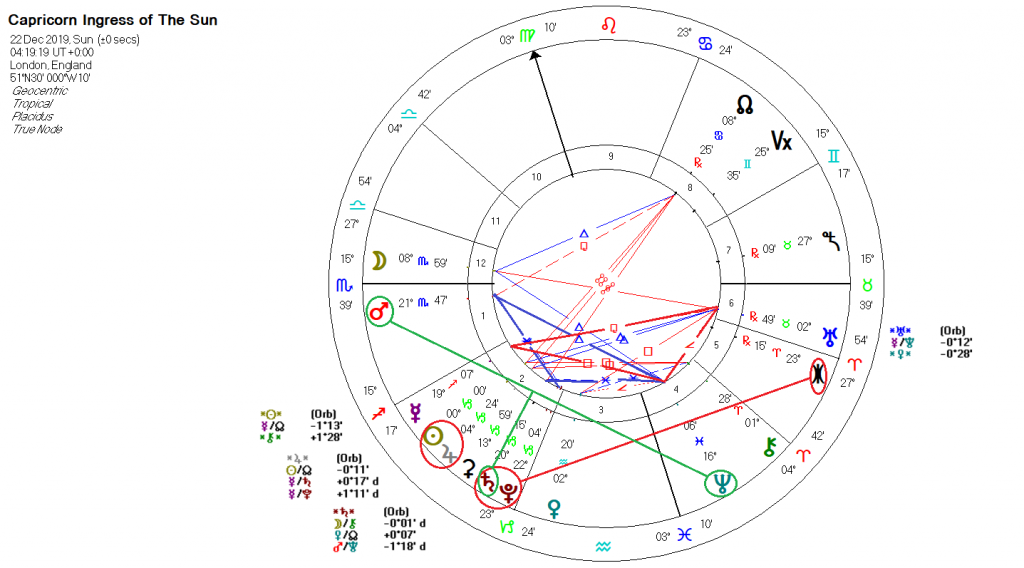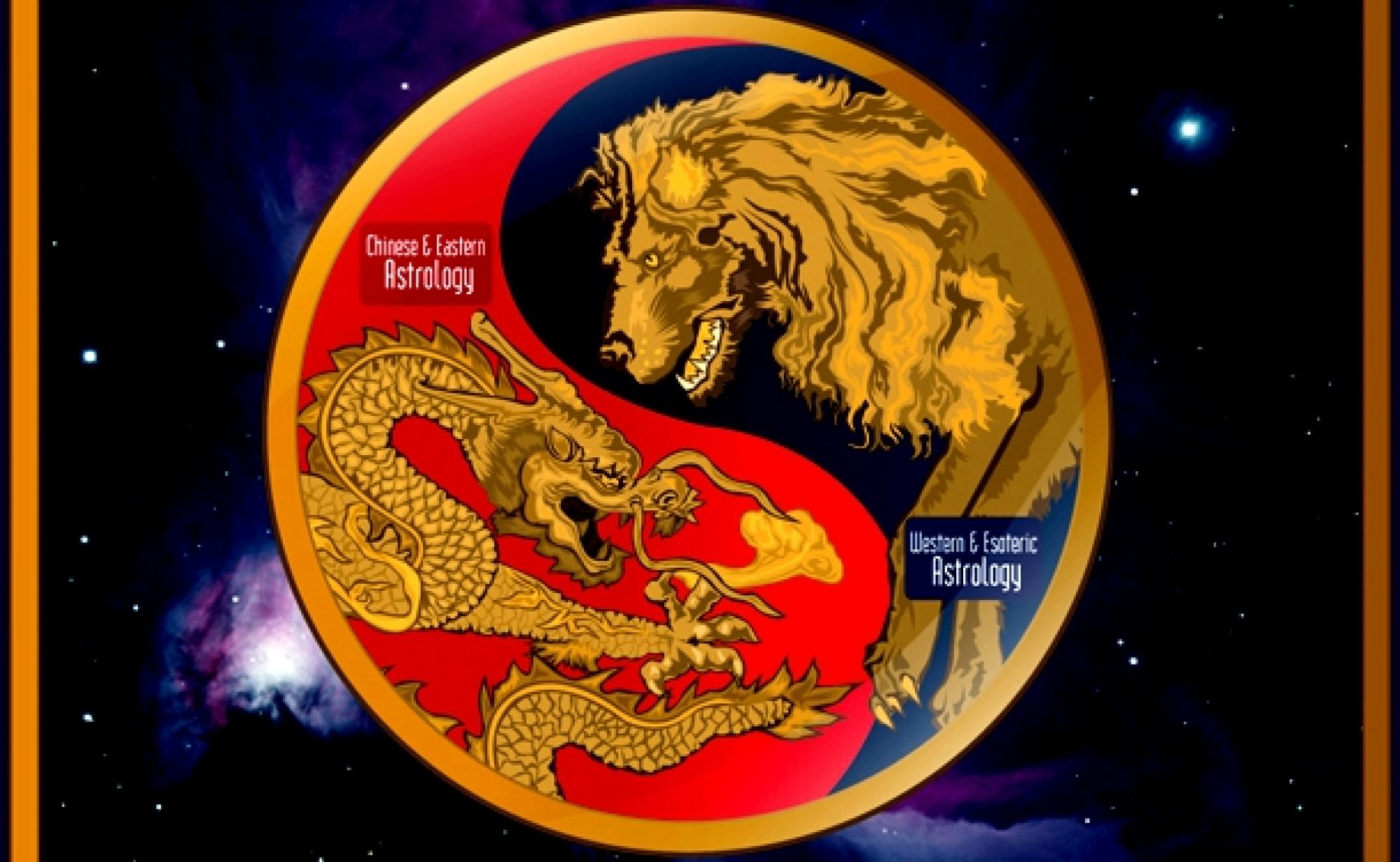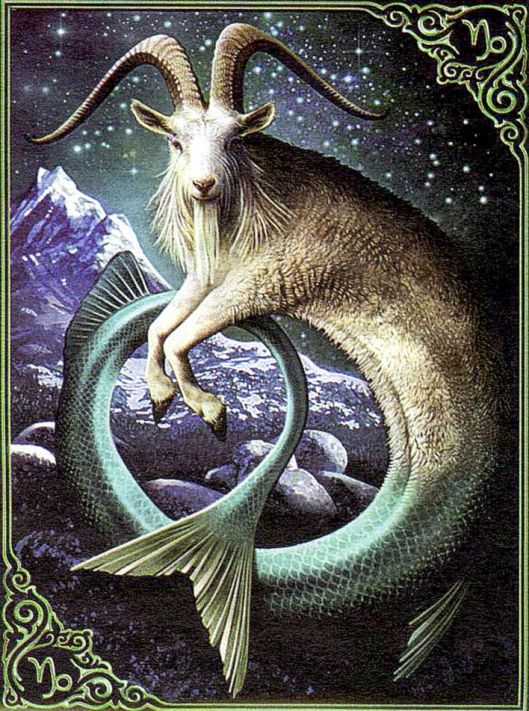On 22 December 2019 the Sun enters Capricorn, setting the primary tone for the quarter leading to Aries. That quarter will be a particularly potent one this year with many follow-on effects. The reasons for stating that will be outlined in the course of this article. The Capricorn quarter always contains the start of the lunar New Year, the year for 2020 being called “The Rat on the Crossbeam”, marking a year of important decisions, from which there is no turning back. To find out what else the quarter and the coming year will entail, read on.
The Capricorn ingress marks the holiday season in Christian nations, its most holy season, coming just before Christmas. This year is especially important, with the ingress itself also marking the 7-year return of the ‘Festival Week of the New Group of World Servers’, as outlined in the books of Alice Bailey. That is also accompanied by a solar annular eclipse (chart), with another eclipse two weeks later, itself accompanied by the much-vaunted Saturn/Pluto conjunction in Capricorn, which last took place in 1518. That will mark some very important changes – epochal changes, coming right to the point. What those are likely to entail are described in a previous article on that conjunction.
To show why this quarter will be such a game-changer, we have the following events taking place then:
- The Festival Week of the New Group of World Servers (21 – 28 Dec)
- Solar annular eclipse, 26 Dec
- Partial lunar eclipse, 10 Jan
- Saturn/Pluto conjunction, 12 Jan, from 15:04 to 18:25 UT
- Chinese New Year, 25 Jan
In fact, there will be a total of six eclipses in 2020, with three in the Gemini/Cancer months and two more at the end of the year – unusual, but not that uncommon. Then, in addition Ceres will be out-of-bounds (OOB) until 19 February. Mars will pass OOB on 12 February, where it will remain until 4 March, a relatively short OOB period for Mars. It will be conjunct Ceres by declination on 16 February. As such, the 2nd half of February next year will be a period to watch, for violence, calamities and for turning points in world affairs.
The chart for the Saturn/Pluto conjunction shows what we might call ‘a geopolitical earthquake of high magnitude’. It is described in the afore-linked article. The conjunction takes place in 12 January. In addition to what is shown on the chart, we also have the Sun, Mars, Saturn and Pluto all in parallel with each other. At the eclipse two days before, the Sun is in parallel with Saturn and Pluto. Mars may as well be. But the quarter gets even better.
To start, we need to consider the solar eclipse in the Festival Week. It takes place on the 5th degree of Capricorn (chart), the Sabian symbol for which reads, “Indians on the warpath. While some men row a well-filled canoe, others in it perform a war dance.” That symbol would be particularly pertinent to the United States, which has been rattling sabres and beating the war drums with several nations recently. We might also consider the case of Bolivia, where the indigenous population is in revolt over the right-wing coup that took place there on 10 November.
Jupiter is conjunct the eclipse point, marking the eclipse as being especially expansive, and making it the lord of the eclipse. Jupiter highlights foreign trade, religious institutions, international law, the wealthy, the stock market and overseas affairs. A trade deal between the US and China perhaps? We probably shouldn’t hold out too much hope for that, especially with the passage of the Hong Kong bill through Congress. If last year was anything to go by, there was a loosening of the tensions around the holidays (Can’t pass up the Christmas sales, can we? We have to keep the voter base happy.), with a snap-back of tensions in the first of this year. It will be rather telling as to the outcomes of that eclipse when Mars contacts the eclipse point exactly on 22 February.
The real eclipse to watch is the 10th of January, with the Saturn/Pluto conjunction being the co-lords of the eclipse, and with Saturn as the primary. This will be addressed later in this article.
To get an idea of where we are headed this quarter it is useful to have a look at what took place in the last quarter. We had the following events:
- Proroguing of UK Parliament ruled illegal
- ‘Ukraine-gate’ is launched
- General election in the UK is announced following a renewed Brexit deal with the EU. Boris got a lump of coal in his trick-or-treat sack instead of Brexit.
- Start of impeachment proceedings against Trump by the House of Representatives
- Rise of protests worldwide, largely against corruption, austerity and neoliberal economic policy
- The Bolivian election, won by Morales, and the subsequent coup
- A million people march in London in support of a people’s vote on Brexit
- Turkish Operation Peace Spring is launched, with subsequent agreements reached between the Kurds and Damascus, the Russians and the Turks, and the occupation of certain oil fileds in eastern Syria by American forces.
- Bibi indicted on fraud charges, after failure for any party to form government in Israel
- Flooding in Venice and across northern Italy
- Elections in Hong Kong see pro-democracy candidates winning big
- There was a transit of Mercury across the face of the sun
Following upon the Mercury transit, and virtually unreported in Western media, including Wikipedia, the 11th annual BRICS summit was held in Brazil. Apparently, BRICS is not that important. But, despite announcements in the past that ‘BRICS is dead’, the meeting in Brasilia this year was largely successful and expansive. And despite pressure from Washington, Bolsonaro stated after his meeting with Xi Jinping,
“…that ‘China is a part of Brazil’s future’ and that Brazil attaches importance to strengthening long-term cooperation with China in a wide range of areas to benefit the two peoples…[and further]… that Brazil is interested in further increasing and diversifying its trade agenda with China – Brazil’s largest trading partner since 2009 – including promoting the growth of Brazilian non-commodity exports to China.”
That statement is quite important, especially for South America, where the US is trying to stem the rising impact of China in the region and seeking to roll back any left-leaning governments. One doubts that Washington would be happy about such news, especially amid growing protests in South America against IMF (re: American) financial policy in the region. Add to that the fact that the five BRICS nations are looking at alternative payment systems to the US dollar, wide-ranging infrastructure investment (which does not include Western interests on the whole) and establishing banking outside the SWIFT system. The move away from hegemony continues.
Why the above items are of importance relates to the forecast from the last quarter: “…the possibility of bold projects being embarked upon, great creative energy and a stimulating exchange of thoughts. This is going to be one of those seasons that will be seen as a balancing period in world and personal affairs, as one would expect from Libra, once hostilities have died down.”
That is pretty much what we saw with the BRICS summit, the fallout from Peace Spring, with negotiations going on now between the Saudis and the Houthis in Yemen, with back-channel talks between the Saudis and Iran and the growing realizations in Europe that the NATO is becoming increasingly irrelevant, if not dangerous.
With all the above in mind, what might we expect in this coming quarter? Well, with the focused meditations during the Festival Week, we can expect events to be precipitated. The chart for the ingress is below (bigger):

The main feature of the chart is the Sun/Jupiter conjunction, with the Sun at the Mercury/Node midpoint: “A positive communion of thoughts with other people, the desire to have intellectual associations, the urge to exchange one’s ideas with others. – A philosophy of life.”
Further, Jupiter is at the Sun/Node midpoint, the reading for which is essentially the same, along with, “Seeking public recognition, generosity, tact, sociableness, harmonious integration into the community. – Successes in the community or in public. Good spiritual or mental contacts.” It is also at the Mer/Sat midpoint (philosophical thinking, the application of method, thoroughness, industriousness. – Success with difficult or irksome work, a fortunate separation,) and the Mer/Plu midpoint (The art of persuasion, the ability to teach, diplomacy. – Recognition by the masses or by the public, great successes.) The latter can also represent crooks or swindlers.
In all, then, this is a much more positive figure than ones we have seen recently and augurs well for goodwill among the nations, at least eventually. If there is to be trouble, it is seen in the Mercury/Neptune square and the associated midpoint Ura=Mer/Nep (A suddenly misguided imagination, convulsive disturbances in connection with the nervous system.). But that can also represent, “A suddenly stepped up power of imagination, ideas, inventions, inspirations.”
And then, there is also what would usually be interpreted negatively, the Sat=Mars/Nep midpoint. However, Mars and Neptune are trine, with Saturn making sextiles to both, so this combination would have to be read as ‘the ability to strongly focus upon one’s inspirations’, or ‘the realization of the limits of one’s sphere of influence’. It is a sobering combination and adds balance to the otherwise overly expansive nature of the Jupiterian influences in the chart.
In effect, what we see with this chart and quarter are the realization of successful negotiations in areas that had otherwise been difficult, the growing realization that certain nations (we won’t say which) do not have the influence they once thought they had, and perhaps a lessening of economic tensions as the quarter unfolds.
The realizations of the limitations of influence will be precipitated by the 10 January eclipse (chart). The effects of that were touched upon in the brief discussion of the Saturn/Pluto conjunction. But in addition, looking at the precipitations form the eclipse, Jupiter moves up to conjoin the eclipse axis exactly on 4 March. The effects will begin to be felt in early February. Mars will be conjunct the eclipse point on 16 March, just in time to kick off the Aries ingress.
To be very clear about what that eclipse entails, the conjunctions to the Sun – Mercury, Ceres, Saturn and Pluto – show a clear turning point in world affairs. Add to that is the exact semisquare by Mars to the Sun/Moon midpoint with the 45° modulus, and we have the makings of a very precipitous and disruptive figure. It will actually be a great blessing when the dust finally settles. And all of that is opposite the Moon – breaks with the past.
To add to that, however, this eclipse also activates another one (13 Jul 18, chart), which had very similar effects to what we can probably expect with the 10 Jan eclipse. In fact, it is at the exact degree of that previous eclipse. That was a solar eclipse, and its activations signalled defeats for the government in the UK, the start of the trade war by the US, along with the first summit with Kim Jong-un (later failed). There were quite a few violent and catastrophic events that happened with the subsequent activations.
The 10 January eclipse will especially affect the UK (I do not expect ‘Brexit by Christmas’), the Saudis, the NATO alliances, Haiti, France, Bolivia, the US, Italy, Ireland, Pakistan, Greece, Germany, north-eastern Syria (Rojava), Egypt, New Zealand, China, the Ukraine and Austria. No doubt, there are others.
As to what effects we might see, we’ll have to leave that as an open question. That depends on the nation and the planets involved. It is just too much to engage here. But by the list, we see the effects on the nations listed having wide-ranging changes, really for the larger world. Especially noteworthy are the US, UK and China, with the propaganda now being levelled at China by the former two nations and the resolution of the recent violence in Hong Kong.
To close, then, this period, and really the whole of 2020, will see sweeping changes in the world order. One of the key phrases for the Chinese New Year is, “The time for decisions has come. There is no turning back.” Indeed, it would appear that we are at ‘that place’. The decisions taken in this interval will not easily be walked back, once instituted. But there is one thing about which we can also be certain: There is no going back to the way things were before this year. Ideas of full spectrum dominance, of empire, of unlimited growth, of unrestrained capitalism, etc., are all on the chopping block. And when all is said and done, that will be a very good outcome.
Merry Christmas and Happy New Year!
Featured pic from The Wild Feminine

